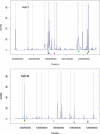Perspectives on human genetic variation from the HapMap Project
- PMID: 16254603
- PMCID: PMC1270010
- DOI: 10.1371/journal.pgen.0010054
Perspectives on human genetic variation from the HapMap Project
Abstract
The completion of the International HapMap Project marks the start of a new phase in human genetics. The aim of the project was to provide a resource that facilitates the design of efficient genome-wide association studies, through characterising patterns of genetic variation and linkage disequilibrium in a sample of 270 individuals across four geographical populations. In total, over one million SNPs have been typed across these genomes, providing an unprecedented view of human genetic diversity. In this review we focus on what the HapMap Project has taught us about the structure of human genetic variation and the fundamental molecular and evolutionary processes that shape it.
Figures



References
-
- Hirschhorn JN, Daly MJ. Genome-wide association studies for common diseases and complex traits. Nat Rev Genet. 2005;6:95–108. - PubMed
-
- Taillon-Miller P, Bauer-Sardina I, Saccone NL, Putzel J, Laitinen T, et al. Juxtaposed regions of extensive and minimal linkage disequilibrium in human Xq25 and Xq28. Nat Genet. 2000;25:324–328. - PubMed
-
- Daly MJ, Rioux JD, Schaffner SF, Hudson TJ, Lander ES. High-resolution haplotype structure in the human genome. Nat Genet. 2001;29:229–232. - PubMed
-
- Patil N, Berno AJ, Hinds DA, Barrett WA, Doshi JM, et al. Blocks of limited haplotype diversity revealed by high-resolution scanning of human chromosome 21. Science. 2001;294:1719–1723. - PubMed
Publication types
MeSH terms
LinkOut - more resources
Full Text Sources
Other Literature Sources

